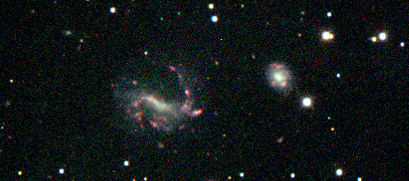
The radial acceleration relation is consistent with a single effective force law with a universal critical acceleration scale.

The radial acceleration relation is consistent with a single effective force law with a universal critical acceleration scale.

A recently discovered dwarf galaxy designated NGC1052-DF2 has been in the news lately. Apparently a satellite of the giant elliptical NGC 1052, DF2 (as I’ll call it from here on out) is remarkable for having a surprisingly low velocity dispersion for a galaxy of its type. These results were reported in Nature last week by van Dokkum et al., and have caused a bit of a stir. It is common for giant galaxies to have some dwarf satellite galaxies.

The Star Forming Main Sequence relates star formation rate to stellar mass. By exploring a large dynamic range in mass with dwarf galaxies, we require the mathematically expected slope that has eluded most work on the subject.
Virginia, your little friends are wrong. They have been affected by the skepticism of a skeptical age. They do not believe except they see. They think that nothing can be which is not comprehensible by their little minds. All minds, Virginia, whether they be men’s or children’s, are little.

I have not posted here in a while. This is mostly due to the fact that I have a job that is both engaging and demanding. I started this blog as a way to blow off steam, but I realized this mostly meant ranting about those fools at the academy! of whom there are indeed plenty.

It has been twenty years since we coined the phrase NFW halo to describe the cuspy halos that emerge from dark matter simulations of structure formation. Since that time, observations have persistently contradicted this fundamental prediction of the cold dark matter cosmogony. There have, of course, been some theorists who cling to the false hope that somehow it is the data to blame and not a shortcoming of the model.

The week of June 5, 2017, we held a workshop on dwarf galaxies and the dark matter problem. The workshop was attended by many leaders in the field – giants of dwarf galaxy research. It was held on the campus of Case Western Reserve University and supported by the John Templeton Foundation. It resulted in many fascinating discussions which I can’t possibly begin to share in full here, but I’ll say a few words.

I have had the misfortune to encounter many terms for psychological dysfunction in many venues. Cognitive dissonance, confirmation bias, the Dunning-Kruger effect – I have witnessed them all, all too often, both in the context of science and elsewhere. Those of us who are trained as scientists are still human: though we fancy ourselves immune, we are still subject to the same cognitive foibles as everyone else.

Reading Merritt’s paper on the philosophy of cosmology, I was struck by a particular quote from Lakatos: A research programme is said to be progressing as long as its theoretical growth anticipates its empirical growth, that is as long as it keeps predicting novel facts with some success (“progressive problemshift”); it is stagnating if its theoretical growth lags behind its empirical growth, that is as long as it gives only post-hoc
Casertano et al. have used Gaia to provide a small but important update in the debate over the value of the Hubble Constant. The ESA Gaia mission is measuring parallaxes for billions of stars. This is fundamental data that will advance astronomy in many ways, no doubt settling long standing problems but also raising new ones – or complicating existing ones.